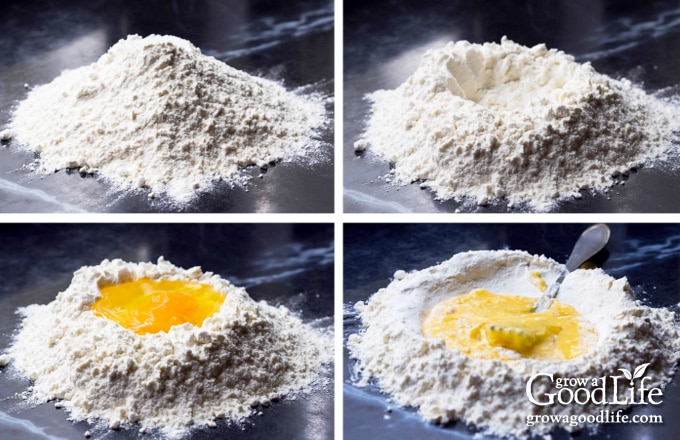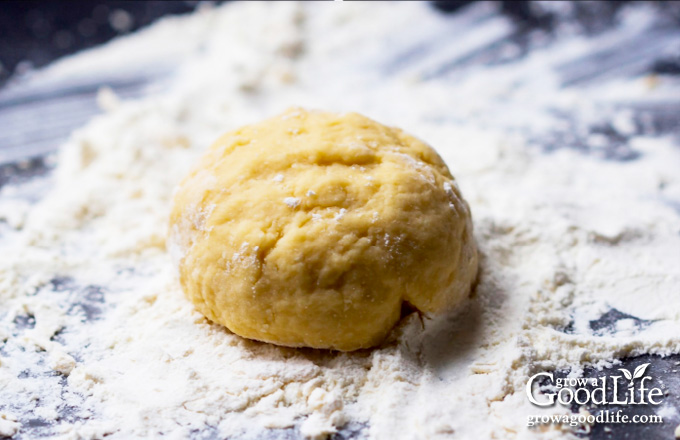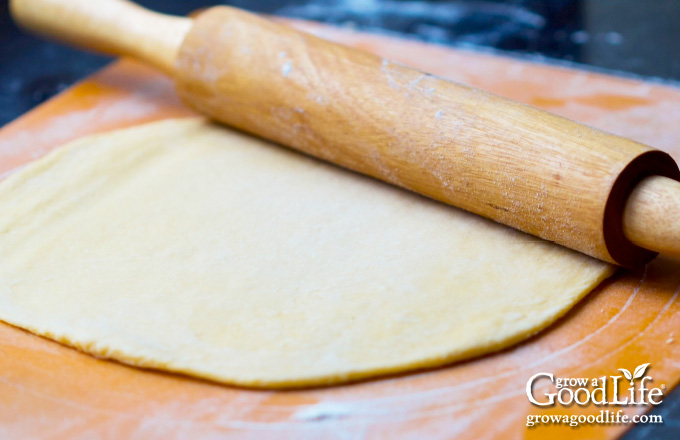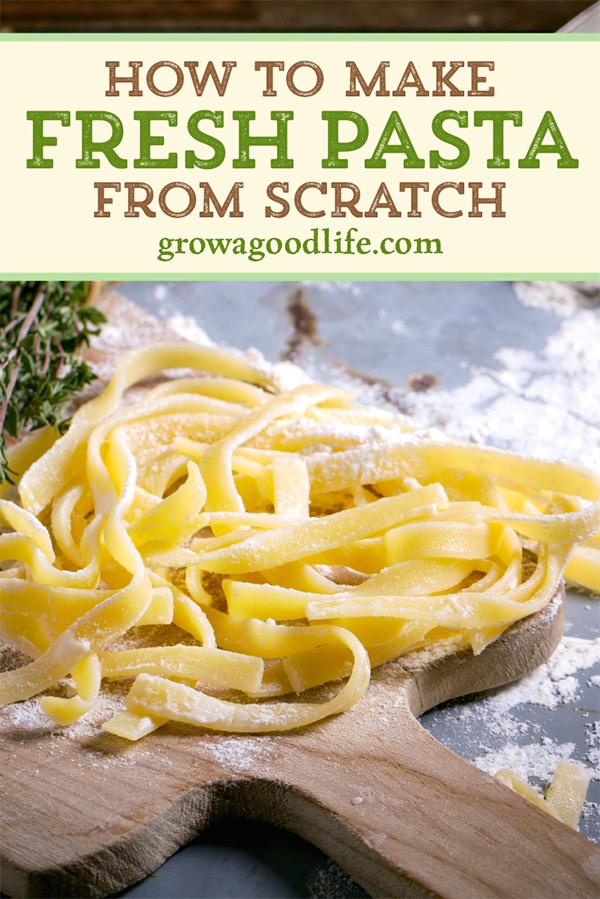How to Make Fresh Pasta from Scratch
This post may contain affiliate links, which means that I may receive a commission if you make a purchase using these links. As an Amazon Associate I earn from qualifying purchases.
It’s easy to make fresh pasta at home. Feed your craving for comfort foods by making homemade pasta from scratch with this simple recipe and tutorial.

Fresh pasta is the perfect dinner when you have only a few ingredients on hand, but feel like making something special. Flour, salt, eggs, and water are all you need to make a basic egg pasta. You can use all-purpose, whole wheat, semolina, or a combination of flours.
Homemade pasta can be cut into various width noodles, sheets for lasagna, or used to make ravioli. Pair freshly cooked pasta with your favorite sauce, pesto, or simply toss with a little olive oil, herbs, and grated Parmesan cheese.
Pasta Flavor Variations:
This recipe is for a basic egg pasta, but you can also add color and flavor with a few ingredient swaps.
- No Egg Pasta: Eliminate the eggs and add 3 Tablespoons of water (4 1/2 Tablespoons, or enough to for a ball of dough.
- Basil Pasta: Eliminate the water and add 3 Tablespoons minced fresh basil.
- Beet Pasta: Eliminate the water and add 1/3 cup cooked beet purée.
- Black Pepper Pasta: Add 2 teaspoons of freshly ground pepper.
- Lemon Pasta: Replace the water with 1 1/2 Tablespoons fresh lemon juice and 1 Tablespoon grated lemon zest.
- Spinach Pasta: Eliminate the water and add 3 Tablespoons minced fresh spinach.
- Pumpkin Pasta: Eliminate the water and add 1/3 cup pumpkin purée and 1/8 teaspoon nutmeg.
Steps for Making Pasta by Hand
A more detailed and printable recipe can be found at the bottom of this article, but these are the general steps for making pasta from scratch:
1. Mix the Dough
On a large cutting board or in a large bowl, add the flour and salt, and mix to combine. Form into a mound and make a depression in the center. Add the eggs and water.
Using a fork or your fingers, beat the eggs and gradually pull the flour into the depression. Continue mixing until all the ingredients are combined into a shaggy dough ball. You may need to add a little water if the dough doesn’t come together into a ball. Add a little extra flour if the dough is too sticky.

2. Knead the Dough
On a well-floured surface, begin kneading the dough by pushing down and away from you. Give the dough a quarter turn, fold, and push it down and away again. Continue kneading until the dough feels smooth, about 10 minutes. Dust with flour as needed to prevent stickiness. Form into a large ball, cover with a kitchen towel, and let the dough rest for 15 minutes at room temperature before shaping it to allow the gluten in the flour to develop.

3. Roll Out the Pasta
Dust your work surface and rolling pin with flour. Cut the dough into pieces and roll out with a rolling pin until the pasta at your desired thickness, about 1/6-inch (2 mm) for tagliatelle and lasagna, and 1/32-inches (1 mm) thick for fettuccine, linguine, and most other noodles. Dust with flour as needed to prevent sticking.

4. Cut the Noodle Shapes
Cut the pasta to your desired noodle shape. I like to use a metal ruler and pizza cutter to get even strips.
- Tagliatelle: 1/2 inch (12 mm) wide
- Fettuccine: 1/4 inch (6 mm) wide
- Linguine: 1/8 inches (3 mm) wide
- Lasagna: 3 1/2 inches (90 mm) wide
Sprinkle the cut noodles with flour, spread out on a baking sheet (or hang on a pasta rack), and let the pasta set until the noodles are dry to the touch, about 15 minutes.

5. Cook the Pasta
While your pasta is setting, prepare your sauce and bring a large pot of salted water to a boil. Shake off any extra flour from the pasta, and add to the boiling water one handful at a time. Give each addition a stir to prevent it from sticking.
Stir the pasta occasionally while cooking until tender, about 1-4 minutes. The cooking time will depend on the thickness of the noodles. Begin testing part way though by pulling out a strand of pasta, letting it cool a bit, and biting into it. Fresh pasta will be tender, but should not taste like flour.
Drain your pasta in a colander and top with your preferred sauce, pesto, or toss with your favorite veggies, and sprinkle generously with grated cheese.
How to Make Pasta from Scratch
Ingredients
- 2 cups unbleached all-purpose flour plus extra for kneading and dusting
- 1/2 teaspoon kosher salt
- 2 large eggs room temperature
- 1 1/2 Tablespoons water plus extra if needed
Instructions
- Combine the flour and salt on a clean work surface (or in a large bowl).
- Form into a mound, make a well in the center, and add the eggs and water.
- Using a fork or your fingers, gradually pull the flour into the well and mix until all the ingredients are combined into a shaggy dough.
- Knead the dough until it feels smooth, about 10 minutes. Dust with flour as needed to prevent stickiness. Add a few drops of water if the dough is dry and crumbly.
- Form into a large ball, cover with a kitchen towel, and let the dough rest for 15 minutes at room temperature before shaping it to allow the gluten in the flour to develop.
- Dust your work surface and rolling pin with flour. Cut the dough into pieces and roll out with a rolling pin until the pasta at your desired thickness. Sprinkle with flour as needed to prevent sticking.
- Cut the pasta to your desired shape. Sprinkle the noodles with flour, spread out on a baking sheet, and let the pasta dry for about 15 minutes before cooking.
- Bring a large pot of salted water to a boil, drop in the pasta, and cook for 1-4 minutes. The cooking time will depend on the thickness of the noodles. Begin testing part way though by pulling out a strand of pasta, letting it cool a bit, and biting into it. Fresh pasta will be tender, but should not taste like flour.
- Drain your pasta in a colander and top with tomato sauce, pesto, or toss with your favorite veggies, and sprinkle generously with grated cheese. Serves 4.
Notes
- No Egg Pasta: Replace eggs with 3 Tablespoons of water (4 1/2 Tablespoons in all, or enough to form a ball of dough).
- Whole Grain Pasta: Substitute the all-purpose flour with whole wheat or spelt flour. Add extra water if needed.
- Basil Pasta: Eliminate the water and add 3 Tablespoons minced fresh basil.
- Beet Pasta: Eliminate the water and add 1/3 cup cooked beet purée.
- Black Pepper Pasta: Add 2 teaspoons of freshly ground pepper.
- Lemon Pasta: Replace the water with 1 1/2 Tablespoons fresh lemon juice and 1 Tablespoon grated lemon zest.
- Spinach Pasta: Eliminate the water and add 3 Tablespoons minced fresh spinach.
- Pumpkin Pasta: Eliminate the water and add 1/3 cup pumpkin purée and 1/8 teaspoon nutmeg.
Nutrition
The idea of making homemade pasta may sound intimidating, but it is much easier than it seems. I hope you’ll try making pasta the way it was originally enjoyed before it became a convenient pantry staple in its dry, boxed form.
You May Also Like
Good planning is key to a successful vegetable garden
Whether you are new to growing your own food or have been growing a vegetable garden for years, you will benefit from some planning each year. You will find everything you need to organize and plan your vegetable garden in my PDF eBook, Grow a Good Life Guide to Planning Your Vegetable Garden.




Will keep this recipe on hand because the noodles taste good. Found the dough to be a little thicker then my normal recipe with 4 eggs and no water.
Jess, Thank you for trying out the recipe and sharing your feedback! I’m glad to hear that you enjoyed the taste of the noodles. If you prefer a thinner dough, you can certainly adjust the amount of water to achieve the desired texture. Feel free to experiment and adapt the recipe to your liking